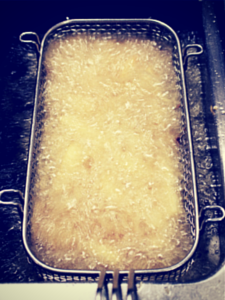 Have you ever heard of a “canola salad oil” versus a “canola fry oil”? What is so different about those oils that makes the fry oil good for frying and the salad oil good for, well, salads — and just about everything else.
Have you ever heard of a “canola salad oil” versus a “canola fry oil”? What is so different about those oils that makes the fry oil good for frying and the salad oil good for, well, salads — and just about everything else.
It’s pretty simple, because there’s only a few factors at play here.
To Begin: Fry Oil vs. Salad Oil

A fry oil is typically made with either canola or soybean oil. These are currently the most common, though some folks are still using corn or cottonseed oil, but it's a little bit more rare.
A salad oil is often also made from canola or soybean… or corn or cottonseed. Really “salad” can be referred to any oil that is commonly used in dressings, so that’s a wide range.
But you really only see this term used to draw comparison to the fry oil. It is a salad oil as compared to the same oil that is a fry oil. (In other words, there’s a Canola Salad Oil because there’s also a Canola Fry Oil — there’s no Extra Virgin Olive Salad Oil.)
Here’s how it all comes together.
The Differences
The biggest difference is that a fry oil contains an anti-foaming agent. This agent’s purpose is to break the surface tension on the top of the oil when it is in a fryer. Most often, the agent used is Dimethylpolysiloxane, and it’s typically added at 5 parts per million, so it’s a few teaspoons to a full truckload of oil.
With this anti-foaming agent, if you put something with a high moisture content in the fryer, it won't spatter or pop dangerous oil and will avoid burning your chefs (hallelujah). This makes it much safer frying in any kitchen.
However, some people prefer not to have that anti-foaming agent in the oil, and when you work with a manufacturer or someone who can custom pack your oils, it should always be an option to leave it out.
Premium vs. Economy Frying Oil
The other difference that can play into the discussion is if you are looking at an economy or a premium frying oil.
Economy fry oils are simply RBD conventional oils (refined, bleach, deodorized & produced using GMOs). So plain old canola or soybean oil oil with anti-foam.
There is also a “premium” type of oil that is ideal for frying, known as “high oleic”. This oil has more monounsaturated fats (the good kind) and can be found in both Non-GMO and GMO varieties.
This high oleic oil is actually produced using a high oleic version of the oilseed — this seed will have a slightly different fat make up, though the oil is produced in the same way as usual.
The thing that makes a high oleic oil premium is that because of its different properties, it will last about 50% longer in the fryer (as compared to normal oil). So it will have a much longer fry life.
This means that you can use less oil over time because you have to change it less often. That will save a good amount money over time, though you will pay more for each jug of oil in the short term.
In Conclusion
These simple terms can sometimes confuse a new oil buyer, but there is less difference between these oils than it may seem. Without bringing the high oleic discussion into the mix, fry oil and salad oil are essentially the same thing with or without the anti-foam agent added.
Topics: Food Service












